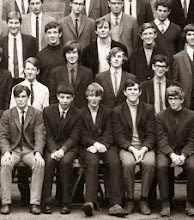
 Towards the end of True North there's a section on the numinous nature of the region's wild landscape. Religious or not, visitors are seldom unmoved by landscapes such as Lindisfarne, or Holy Island, and shrines such as the little chapel of the 'Four Cs', saints Cedd, Chad, Caewlin and Cynebil, at Lastingham. One regular walker is the rock musician Julian Cope (The Teardrop Explodes, Brain Donor et al) who is greatly interested in other rocks - the mysterious monoliths and stone circles left by our ancestors in the distant past.
Towards the end of True North there's a section on the numinous nature of the region's wild landscape. Religious or not, visitors are seldom unmoved by landscapes such as Lindisfarne, or Holy Island, and shrines such as the little chapel of the 'Four Cs', saints Cedd, Chad, Caewlin and Cynebil, at Lastingham. One regular walker is the rock musician Julian Cope (The Teardrop Explodes, Brain Donor et al) who is greatly interested in other rocks - the mysterious monoliths and stone circles left by our ancestors in the distant past.Penny and I, and a group of friends from my old Bradford Telegraph & Argus days, discovered the excellent circles and other remains above Boot on a week's walking holiday at the end of last month. Take the path through Eskdale Mill (run by a delightful family and still grinding flour with its two huge waterwheels), climb the fellside through an abandoned group of farm buildings and loop gently to the left. At least three circles lie in the tawny grass with views of Harter Fell one way (above) and the Scafells another. Certainly a numinous place.

Cope doesn't describe these ones but he has a good selection from the North in The Modern Antiquarian, (Thorson's 2000), including some in places since disturbed by modern man, such as fields by the M6 at Shap. The book's only disadvantage is its vast size, a monolith in itself and impractical to take on walks.

Julian Cope is worthy of study. I love his album, Jehovakill. He's a bit of a mad druid and I especially appreciate his allusion to the fact that the symbol of the cross as referred to in Christianity is in fact older in Celtic lore and actually, rather than referring to someone being nailed to a piece of wood, really refers to a simple symbol of a human being with arms outstretched to the universe and existence.
ReplyDeleteHi Graham - and thanks again for your excellent Manchester pictures which will appear here soon. Very interesting about the cross - an example of the way that successive religions borrow from their predecessors and build on them. You certainly feel a sense of awe and kinship at places such as the Boot stone circles. I wish we could know more about the people who laid them out, how they did so and why. All v best, M
ReplyDeleteHi Martin and thanks again for your kind words about my shots. In some ways I wish I had been using my big Leica R5 but these days 35mm film is dying out and can be impractical for the web. That's why I carry what I refer to as my "pap camera" when I travel these days - a small unobtrusive Sony Cybershot. That camera was used for all the shots I sent you.
ReplyDeleteAs for stone circles - I also wish I knew more about their history. Having had my hippy days and having spent time at a few good ones whilst camping in a VW camper van, I reckon most of them have a percievable energy which I can't explain. Maybe it is purely psychological and self created, but I don't get why it happens every time I visit one of these places.
I have slept at Nine Ladies stone circle in Derbyshire on numerous occasion and also spent a few times at Arbor Low. I've never been to Stonehenge but I think that place is overused anyway; there are many more examples of standing stones in Britain. My most recent experience was this summer while my wife and I were travelling through the depths of Dumfriesshire on our holidays. We found a circle while driving through forest and got out to have a look. I didn't even know what it was called or anything about its history - I just lay down in the centre of it in the Scots afternoon sunlight with the panorama all around me and felt some incredible energies (maybe I was fooling myself but nevertheless, it felt powerful enough at the time to make me burst into tears.
Mind you, I'm just a sentimental artist.